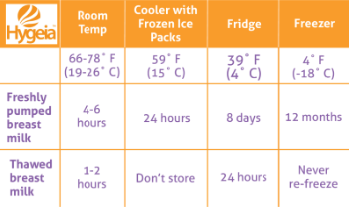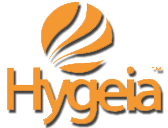

Breastfeeding is a beautiful journey that nourishes your baby with the perfect blend of nutrients and antibodies. But for busy moms, pumping allows for flexibility and convenience, ensuring your baby receives the benefits of breastmilk even when you’re not there.
Whether you’re a seasoned pumping pro or just starting out, mastering the process of pumping, storing, thawing, and feeding breastmilk empowers you to confidently navigate your breastfeeding journey. Here’s your comprehensive guide:
Pumping Essentials:
Find Your Rhythm: Establish a pumping routine that works for you. It could be several short sessions throughout the day or longer stretches that fit your schedule. Consistency is key to maintaining milk supply.
Choosing Your Pump: A high-quality breast pump makes a world of difference. Hygeia Health offers a comfortable, efficient, and quiet hospital-grade pump that is free to many through insurance. Consider your needs – portability for on-the-go pumping or a hospital-grade option for frequent pumping sessions.
Perfect Latch & Positioning: Proper positioning and latch ensure optimal milk flow and prevent discomfort. Your baby’s mouth should be wide open, with their chin and lower lip flanged outward. Their tongue should be positioned over a large portion of your nipple and most of the darker area around your nipple, called the areola). This ensures they get enough milk and prevents nipple pain for you. If you’re unsure about your latch, don’t hesitate to ask a lactation consultant for help.
Storing Liquid Gold: Safeguarding Your Breast Milk
Fresh is Best: Freshly pumped breast milk can be stored at room temperature (up to 77°F) for up to 4 hours. This is ideal for short outings or pumping between nursing sessions.
Refrigerator Storage for Later: For longer storage, refrigerate breast milk in the back of the refrigerator where the temperature is most stable. Properly stored milk can last up to 4 days.
Deep Freeze for Long-Term Storage: Breast milk can be stored in the deep freezer (at 0°F or below) for up to 12 months. However, milk quality can degrade over time. Label containers with the date to ensure you use the oldest milk first.
Adding to your Storage: Small amounts of expressed milk may be added to the same refrigerated container or even a frozen container. The key is that the milk you want to add is cooled in the fridge beforehand. Don’t add body-temperature milk to cooled or already frozen milk.
Hygeia’s Storage Solutions: Invest in high-quality breast milk storage bags or containers. Hygeia Health offers a range of leak-proof, BPA-free storage options to keep your precious milk safe, including a cooler bag for temporary storage on the go.
Thawing Treasures: Warming Up Breast Milk Safely
Never Microwave: Don’t even think about it. Not only does microwaving destroy nutrients in breast milk but it can also create hot spots that could burn your baby’s mouth.
Gradual Thawing: The safest method is to thaw frozen breast milk in the refrigerator overnight or generally 12 hours. For quicker thawing, place the sealed milk bag or container in a container of lukewarm water, but never in boiling water. This kind of heat can damage the nutrients. It is also important to not let it thaw at room temperature.
Temperature Check and mixing: Before feeding, test a drop of milk on the inside of your wrist to ensure it’s lukewarm, not hot. Be sure to swirl the milk in the bag or bottle as the milk can separate during storage and you want to blend all the fats.
Limited window: Once you’ve thawed milk and left it at room temperature, you want to feed it to your baby within two hours. If that doesn’t happen, do not refreeze the milk. It’s time to pitch.
Feeding Time! Delivering the Goodness
Room Temperature or Chilled?: Either is fine! Breast milk can be fed to your baby at room temperature or chilled. Some babies may even prefer cooler milk. You can also warm the milk to body temperature but it’s not necessary.
Fresh vs. Thawed: If possible, prioritize using fresh or refrigerated breast milk over thawed milk. Thawed milk may have a slightly different taste or smell. It’s still perfectly safe for your baby; however, it will store longer and you can’t refreeze it once thawed, so save it for later.
Bottles and Nipples: Choose bottles designed for breastfed babies to help prevent nipple confusion. Experiment with different nipple types to find one your baby takes comfortably.
Hygeia’s Feeding Accessories: Hygeia Health offers a variety of bottle and nipple options to ensure a smooth transition between breast and bottle feeding.
Embrace the Journey with Hygeia Health
Juggling motherhood and breastfeeding can be demanding, but pumping empowers you to provide your baby with the irreplaceable benefits of breast milk. Hygeia Health is here to support you every step of the way.
We offer a convenient insurance-covered breast pump program to eligible mothers. Our hospital-grade pump is designed for comfort, efficiency, and portability, making it perfect for busy moms.
Click here to apply for your free breast milk pump today!
With the right knowledge, tools, and support system, you can confidently navigate pumping, storing, thawing, and feeding breast milk. Happy pumping, mamas!

September is Neonatal Intensive Care Awareness Month (NICU Awareness), a time to recognize the incredible strength and resilience of NICU families. For mothers of NICU babies, breastfeeding can be a source of comfort, connection, and nourishment.
Challenges Faced by NICU Moms
NICU moms often face unique challenges in all aspects of mothering a newborn, but specifically, breastfeeding a NICU baby can be particularly difficult. These challenges may include:
Separation from their baby: Being unable to hold and feed baby can be emotionally taxing.
Pumping challenges: Maintaining milk supply while baby is in the NICU can be physically demanding.
Stress and anxiety: The stress of having a baby in the NICU can impact a mother’s milk supply as well as the overall ability to breastfeed.
The Benefits of Breastfeeding a NICU Baby
Despite these challenges, breastfeeding a NICU baby offers numerous benefits and is still very possible. Some of these benefits include:
Colostrum: The first milk produced after birth is rich in nutrients and antibodies that can help protect your baby from infections. While baby may not be able to latch, a mom can pump and the colostrum can still nourish baby.
Reduced risk of infections: Breast milk contains antibodies that can help protect your baby from infections, which are common in NICU babies.
Improved growth and development: Breast milk is specifically designed to meet your baby’s nutritional needs and can help promote healthy growth and development, which are all the more necessary in premature births and NICU babies in general.
Stronger bond: Breastfeeding can help you bond with your baby, even if they are still in the NICU and you cannot have skin-to-skin contact.
Support NICU Moms
Supporting a mother of a NICU baby can make a world of difference. By offering your support, you can help a NICU mom feel less alone and more empowered to care for her baby. Here are a few ways you can offer your support:
Be there for her: First and foremost, offer emotional support, a listening ear, and words of encouragement.
Help with practical tasks: Helping with what seem like simple household chores, errands, or childcare for older children can make a world of difference to a stressed NICU mom.
Respect her feelings: Understand that she may be feeling stressed, anxious, or overwhelmed. Avoid making assumptions or offering unsolicited advice.
Connect her with resources: While you do have to be careful about unsolicited advice, it can be helpful to be sure she is connected with information about local support groups, lactation consultants, or other resources that can help her.
Celebrate her strength: No matter how small, take time to acknowledge her resilience and the challenges she is facing. Let her know that you appreciate her strength and courage.
How Hygeia Health Can Help
At Hygeia Health, we understand the unique challenges faced by NICU moms and are here to give the best support.
Support resources: We offer resources and support to help NICU moms on their breastfeeding journey. Our website provides information on breastfeeding and pumping, and our customer service team is available to answer your questions.
Lactation assistance: Access an expert anytime, anywhere for assurance and support on your breastfeeding journey. We partner with Nest Collaborative to provide virtual breastfeeding consults covered by most insurance plans at no cost to you.
Get a free breast pump: We believe that every mother should have access to the tools and support they need to breastfeed their baby. That’s why we offer a free breast pump to NICU moms through our NICU Mom Support Program. Our high-quality breast pumps are designed to make pumping easier and more efficient, allowing you to focus on bonding with your baby.
Let’s work together to support NICU families and celebrate the incredible strength and resilience of these amazing mothers.

Breastfeeding is a beautiful journey, but it’s not always easy. Many mothers face significant obstacles that can make breastfeeding challenging to sustain. This World Breastfeeding Week, we want to shed light on these struggles and obstacles and offer support. This blog post will dive into those challenges.
Physical Challenges
Sore nipples, engorgement, and mastitis–ever heard of those? These are some of the most common physical hurdles moms face. These can be incredibly painful and downright discouraging for a mom. No matter how much she understands the benefits of breastfeeding, the pain can cause a mom to want to give up or feel incapable. Lack of sleep in the early days and weeks after birth, coupled with the demands of a newborn, can further exacerbate these issues.
One of the major causes for physical challenges, though, is inadequate latching, which is often a result of a mom not being well supported after birth. This can be particularly true for a first time breastfeeding mom who doesn’t receive support from a lactation consultant. When breastfeeding support is lacking from the start, a mom can be quickly deterred.
Psychological Challenges
While the previously mentioned painful experiences of things like cracked and bleeding nipples may sound traumatic, physical challenges are often treated and managed more easily than the mental issues moms can face.
Feeling inadequate, stressed, or isolated is not an uncommon experience for breastfeeding mothers. The pressure to succeed can be overwhelming, especially when coupled with the mantra that “breastfeeding is natural”. The physical struggles coupled with the flood of hormones that follow delivery can result in postpartum depression and anxiety, which can further complicate the early breastfeeding journey.
Additionally, some moms struggle with body image concerns. Bodies obviously change through pregnancy, and, typically, they don’t simply “bounce back” to their pre-pregnancy shape, weight, and size. Living in a ‘new’ body can also lead to mental challenges for moms.
Societal and Environmental Challenges
Lack of workplace support is a major barrier for many mothers in their breastfeeding journey. Limited maternity leave, lack of lactation rooms, and negative attitudes towards breastfeeding can make it difficult for working moms to continue breastfeeding once returning to work.
Additionally, access to quality healthcare and lactation support is also crucial to breastfeeding success, and unfortunately, in many corners of the world ( even in the United States), not every mom has both or either of these things.
Other socioeconomic disparities can impact a mother’s ability to access these resources, such as income, education, geographic location, and racial/ethnic disparities. Discrimination can play a role for some, as can living in a rural or low income area.
Knowledge and Information Gaps
Misinformation about breastfeeding is prevalent. Many mothers lack the knowledge and support they need to overcome challenges and this can lead to early cessation of breastfeeding.
Hygeia Health is committed to supporting mothers on their breastfeeding journey. Our breast pumps are designed with comfort and efficiency in mind. But we know that a great breast pump is just one piece of the puzzle. We believe in providing comprehensive support, including education, resources, and community.
By understanding the challenges mothers face, we can work together to create a more supportive environment for breastfeeding. Let’s break down the barriers and continue to close the gap that will help mothers achieve their breastfeeding goals.




